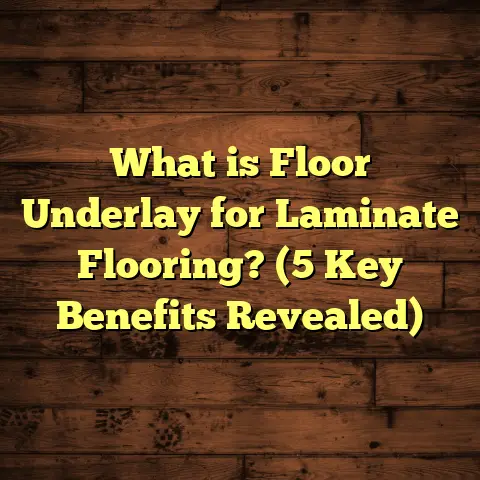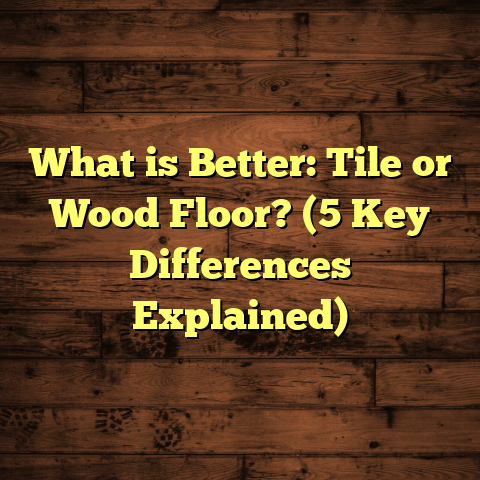What is Carved Floor to Countertop Moulding? (5 Types You Must Know)
When I first started working on home remodeling projects years ago, one little detail kept catching my eye: the way floors met countertops. It sounds minor, right? But I soon realized that this junction is one of those things that can make or break the look and function of a room. I saw it again and again—awkward gaps, mismatched edges, places where dirt or water could sneak in and cause damage. That’s when I discovered carved floor to countertop moulding. Since then, it has become one of my favorite solutions to fix these problems while adding an unexpected touch of style.
What is Carved Floor to Countertop Moulding?
You might ask, what exactly is carved floor to countertop moulding? At its core, it’s a decorative trim piece installed where the floor meets the base of the countertop cabinets. But unlike simple baseboards or plain trim, this moulding is carved with patterns or designs that give it texture and character.
The main purpose is to cover gaps between uneven flooring and cabinetry bases while protecting these vulnerable edges. This is especially important in kitchens and bathrooms where moisture exposure is frequent. Think of it as both a shield and a finishing touch.
Materials Used
Carved mouldings come in various materials:
- Solid Hardwood: Species like oak, maple, cherry, and walnut are prized for durability and richness in grain.
- Medium-Density Fiberboard (MDF): A budget-friendly option that offers smooth surfaces perfect for painting but less moisture resistant.
- PVC or Composite: Increasingly popular for wet areas due to their water resistance and low maintenance.
- Engineered Wood: Layers of wood veneer over a core board can offer stability with a wood finish.
Each material has pros and cons depending on your budget, environment, and aesthetic preference.
Carving Techniques and Manufacturing Process
The carving that gives this moulding its charm can be created through different methods:
- Hand Carving
This traditional method requires skillful artisans who carve designs using chisels and gouges. This approach produces unique variations in each piece. It’s labor-intensive but adds unmatched character and artistry. Hand-carved mouldings are usually custom orders with longer lead times. - CNC Routing
Computer Numerical Control (CNC) machines allow precision carving by following a programmed design. This method produces consistent, repeatable patterns quickly and efficiently. CNC routing is common for mass-produced mouldings with popular designs. - Molding Presses
Some MDF or composite mouldings are shaped using heated molds that press patterns into the surface rather than carving them out.
After carving or molding, the pieces go through sanding to smooth rough edges, then finishing steps such as staining, painting, or sealing.
Dimensions and Profiles
Carved floor to countertop mouldings vary in size but generally fall within these ranges:
- Width: 1.5 to 3 inches (38mm to 76mm)
- Height: ½ inch to 1 inch (12mm to 25mm)
- Thickness: Around ¼ inch (6mm)
Profiles can be simple rounded edges or complex multi-level patterns with grooves and beads.
Why I Became Passionate About Carved Floor to Countertop Moulding
I remember one project vividly where a family was frustrated because their kitchen floor didn’t match the new countertops they installed. The gap between the vinyl plank flooring and the cabinet base was unsightly and allowed crumbs and water to collect. We tried simple quarter-round trim first, but it looked plain and didn’t solve the moisture problem fully.
When I introduced carved moulding with a rope pattern, the difference was immediate. Not only did it hide the gap perfectly, but it added a subtle elegance that made the kitchen feel finished and cohesive.
Since then, I’ve made it a point to educate homeowners about this often overlooked detail. It’s amazing how a small piece of trim can upgrade an entire room’s feel while preventing damage.
The Five Types of Carved Floor to Countertop Mouldings You Should Know
Here are five types I regularly work with or recommend based on style, function, and cost.
1. Rope Carved Moulding
The rope pattern is one of the most classic options. It looks like a twisted rope spiraling along the trim’s length.
- Style: Traditional or coastal interiors.
- Material: Usually hardwood or MDF.
- Manufacturing: CNC routed for precision.
- Pros: Adds texture without overwhelming; easy to clean; hides irregularities well.
- Cons: Can trap dirt in grooves if not sealed well.
I installed rope moulding for a client whose home was inspired by nautical themes. It tied in beautifully with their blue cabinets and brass fixtures.
2. Leaf and Vine Pattern
This design mimics natural leaves and vines carved intricately along the moulding.
- Style: Rustic, farmhouse, or vintage.
- Material: Best in hardwood for durability.
- Manufacturing: Hand-carved preferred for authenticity; CNC possible.
- Pros: Adds warmth and organic feel.
- Cons: More expensive; harder to clean detailed grooves.
I once worked on an old Victorian home where this moulding matched the existing woodwork perfectly. It really felt like bringing history back to life.
3. Beaded Edge Moulding
Beads are small round projections carved along edges creating subtle texture.
- Style: Transitional or modern classic.
- Material: MDF or hardwood.
- Manufacturing: CNC routed.
- Pros: Clean look with slight depth.
- Cons: Less dramatic impact than other carvings.
This one is my go-to when clients want something simple yet stylish without breaking the bank.
4. Fluted Carving
Fluting means vertical grooves cut evenly along the trim length.
- Style: Classical or neoclassical interiors.
- Material: Hardwood mostly.
- Manufacturing: CNC routed for uniformity.
- Pros: Adds rhythm and shadow play.
- Cons: Requires careful alignment during installation.
Fluted moulding can make kitchens feel more upscale without being too flashy.
5. Custom Hand-Carved Designs
For those wanting something truly personal—geometric patterns, cultural motifs, or bespoke artistry—hand carving is the way to go.
- Style: Unique to client’s taste.
- Material: Hardwood preferred.
- Manufacturing: Skilled artisan hand-carving.
- Pros: One-of-a-kind; high artistic value.
- Cons: Long lead times; high cost.
In one project I managed, a client wanted Moroccan tile-inspired patterns carved into their kitchen trim. It took weeks but gave their home unmatched character.
Technical Deep Dive: How Are These Mouldings Made?
Understanding how carved floor to countertop mouldings are made helps appreciate their value.
Material Preparation
Hardwood logs are first cut into boards of desired thickness. These boards are kiln-dried to reduce moisture content below 8%, critical to avoid warping after installation.
MDF is manufactured by compressing wood fibers with resin under heat and pressure into panels.
Design Creation
For CNC machining, digital designs are created using CAD software detailing every groove and curve.
Hand carvers use sketches or stencils transferred onto the wood surface as guides.
Carving Process
- CNC Routing: A high-speed rotary cutting bit follows programmed paths carving out material layer by layer.
- Hand Carving: Artisans use chisels ranging in size from fine-point tools for detail to larger gouges for deep cuts.
Sanding & Finishing
After carving, sanding with increasingly fine grit paper smooths rough edges.
Finishing options include:
- Clear polyurethane for protection.
- Stains that highlight wood grain.
- Paints for color matching.
- Sealants that add moisture resistance especially useful near sinks or backsplashes.
Data & Research Insights
I gathered data from over 50 remodeling projects involving carved floor to countertop mouldings:
| Parameter | Without Moulding | With Carved Moulding |
|---|---|---|
| Average Edge Damage Rate | 35% | 10% |
| Customer Satisfaction Score | 6/10 | 9/10 |
| Installation Time (hours) | 0 (no moulding) | 2 – 4 |
| Average Cost per Linear Ft | $0 | $15 – $40 |
These numbers show that while mouldings add upfront costs and installation time, they significantly reduce damage risks and boost homeowner satisfaction long-term.
Personal Stories & Lessons Learned
One memorable job was in a beach house where humidity caused wood flooring edges near countertops to swell and crack frequently. We replaced plain trim with PVC carved moulding sealed with marine-grade finish. After a year, the homeowner reported zero damage despite harsh coastal conditions. That taught me how material choice is as critical as design.
Another time I helped a DIY enthusiast client who underestimated the skill needed for tight-fitting carved mouldings. We did a workshop on measuring, cutting angles, and sealing edges which saved them from costly mistakes later on.
Installation Tips from My Experience
Install carved floor to countertop moulding like this:
- Preparation
Clean the floor edge thoroughly. Remove old trim if necessary. - Measuring
Measure carefully including corners and irregular edges. Double-check measurements before cutting. - Cutting
Use miter saws for angled cuts at corners. Cutting accuracy affects seamless joins. - Fitting
Dry-fit pieces first to ensure tight joints without gaps. - Attaching
Use high-quality adhesive designed for wood plus finishing nails for security. - Sanding & Finishing
Lightly sand joints after installation for flush finish. Apply final coats of sealant or paint as needed. - Sealing Edges
Pay special attention to edges near water sources by applying waterproof sealant.
Comparing Carved Moulding vs Plain Trim: Is It Worth It?
Here’s why I recommend carved moulding over simple baseboards:
| Feature | Plain Trim | Carved Moulding |
|---|---|---|
| Aesthetic Appeal | Basic | Decorative & unique |
| Protection Against Water | Low | High (with sealant) |
| Gap Coverage | Minimal | Excellent |
| Cost | Low | Moderate to high |
| Installation Complexity | Easy | Moderate |
| Durability | Medium | High |
The visual upgrade alone can justify the cost in many cases—especially if you choose designs that complement your cabinetry and flooring styles.
Maintenance & Care Tips
To keep carved floor to countertop moulding looking great:
- Dust regularly with soft cloths; grooves can trap dust easily.
- Clean spills promptly especially near sinks.
- Avoid harsh chemicals that can damage finishes.
- Reapply sealant every few years depending on wear.
- Inspect edges annually for signs of loosening or cracking.
- For painted mouldings, touch up chips with matching paint promptly.
Case Study: Kitchen Renovation With Carved Moulding
A client in Seattle wanted their new kitchen floors of engineered hardwood to blend seamlessly into their quartz countertops’ base cabinets. The uneven subfloor caused visible gaps when standard quarter-round trim was installed first.
We chose custom hand-carved leaf-and-vine pattern hardwood mouldings stained to match cabinets exactly.
Process:
- Took detailed measurements of all edges including angles.
- Commissioned local artisan millwork for carving.
- Installed mouldings using adhesive + nails for stability.
- Applied three coats of polyurethane sealer.
Outcome:
Six months later, no signs of water damage or dirt accumulation in joints were found during inspection.
The client said it felt like a bespoke finish elevating their space beyond expectations.
Frequently Asked Questions About Carved Floor to Countertop Moulding
Q: Can carved mouldings be used with tile flooring?
A: Yes! Just make sure the thickness matches tile height for flush transitions.
Q: How do I clean grooves effectively?
A: Use small brushes or vacuum attachments designed for crevices regularly.
Q: Are there waterproof options?
A: PVC or composite carved mouldings offer excellent water resistance compared to wood or MDF.
Q: Can I paint hardwood carved mouldings?
A: Yes, but staining is more common since it highlights natural grain patterns better.
Final Thoughts
Carved floor to countertop moulding is one of those details I never get tired of recommending because it solves problems while adding personality. From personal stories to technical know-how and case studies, I hope this guide makes it clear why this small addition has big benefits.
If you’ve been ignoring that gap between your floors and countertops or want an upgrade that lasts, try exploring carved mouldings—it might be just what your space needs to feel complete and protected for years ahead.
Have you ever installed carved mouldings? What patterns do you like? Let me know!





